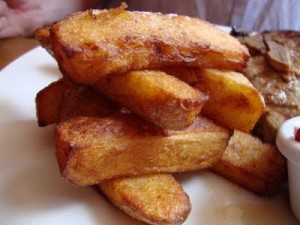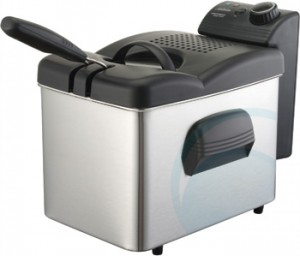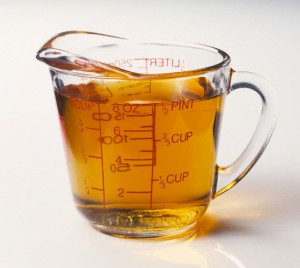Your guide to deep frying healthier hot chips
February 15th, 2012
 Just because your hot chips are cooked in a vat of boiling oil, it doesn’t mean they have to be entirely unhealthy. It is possible to use your deep fryer to get crisp and tasty chips while minimising the health risks.
Just because your hot chips are cooked in a vat of boiling oil, it doesn’t mean they have to be entirely unhealthy. It is possible to use your deep fryer to get crisp and tasty chips while minimising the health risks.
Today Appliances Online will take you through some ways to make your home-fried chips a cut above those of the local takeaway, not only in terms of healthiness, but taste as well.
On oil
 When looking for an oil in which to deep fry your chips, try to find one with a high Smoking Point and a high Monounsaturated Fat content:
When looking for an oil in which to deep fry your chips, try to find one with a high Smoking Point and a high Monounsaturated Fat content:
- The Smoking Point of oil is, predictably, the point at which oil starts giving off smoke when heated. When oil reaches this point, its chemical composition changes, reducing the quality of the oil, making it unhealthier and increasing the likelihood of spoiling.
- While otherwise very healthy, olive oils have low smoking points. Vegetable, canola, sunflower, safflower and rice bran oils tend to have higher smoking points, making them better choices for deep frying.
- All cooking oils contain fats, but each variety uses different proportions of different fat types. The healthiest choices for you are those with high percentages of Monounsaturated Fats, which also make the oil more stable for longer-lasting freshness.
- A good guideline is to look for an oil with the National Heart Foundation Tick; check out the Foundation’s list of products that meet its high standards.
On chips
 Whether you’re preparing your own home-made chips, or using a frozen bag from the supermarket, the healthiest choices for deep frying are big fat steak fries and wedges. Shoestring fries and crinkle-cut chips have a higher surface area to volume ratio, meaning they absorb more oil when compared to their potato content.
Whether you’re preparing your own home-made chips, or using a frozen bag from the supermarket, the healthiest choices for deep frying are big fat steak fries and wedges. Shoestring fries and crinkle-cut chips have a higher surface area to volume ratio, meaning they absorb more oil when compared to their potato content.- When making your own chips from scratch, you’ll need to blanch them before frying in order to pre-cook the inside of the chips. While it’s possible to do this in your deep fryer, set to a lower temperature, this also increases the likelihood of your chips absorbing and becoming soggy with oil. A healthier option would be to blanch your chips in boiling water, then drain and dry them off before frying.
- When cooking frozen chips (again, the National Heart Foundation has several recommended varieties), it’s healthier to cook them while still frozen rather than letting them thaw (though take care to remove any ice chunks attached to the chips, as oil and water does not mix). This will let the hot oil instantly cook and seal the outside of the chips with a crispy crust, and the inside will be steamed from the inside out, with any escaping steam keeping oil away from the chip and preventing absorption. Thawed chips will allow more oil to seep into the chips themselves for less healthy results.
On cooking
 Healthy deep frying means cooking quickly at high temperatures.
Healthy deep frying means cooking quickly at high temperatures.
- For chips, your best bet is to heat your oil to approximately 185°C – any higher and you’ll damage the oil; any lower and the chips will take longer to cook and absorb more oil.
- Don’t overload your deep fryer with chips – too many chips in the fryer will lower the temperature of the oil, making the chips take longer to cook and absorb more oil.
- Different-sized deep fryers provide different levels of performance (check your manual), but as a rule you want to cook your chips as fast as possible – the longer you leave the chips in the deep fryer, the more oil they’ll absorb. About 5 minutes should be about right for most big chips – if your deep fryer manual gives a range of cooking times (e.g. 7-15 minutes), try to err towards the shorter time.
- Drain the chips well once they’re done to keep any additional oil clinging to their surface from soaking into them.
On recycling oil
 While the healthiest option possible would be to use fresh oil every time you deep fry, this is not a financially practical solution.
While the healthiest option possible would be to use fresh oil every time you deep fry, this is not a financially practical solution.
- When re-using oil, remember to skim and filter it (once it cools to room temperature) to remove crumbs and food particles that can alter the flavour and sometimes the healthiness of your deep fried food.
- If storing the oil for later use, once it cools to room temperature you can pour it into an airtight container and keep it in the refrigerator or a cool dark place to minimise spoilage and get more use out of the oil.
- If oil changes colour or odour, or smokes when heated, it should no longer be re-used.
Results
Well, not as healthy as say, a salad. But healthier then your average deep fried chips. Though this doesn’t mean you should eat them every day – keep them as a sometimes food.
- If you want to make your chips even healthier, why not try not deep frying them at all? After blanching them (in the case of home-made chips), try oven roasting your chips. It takes longer, but the results may be worth it in terms of both healthiness and taste.
- Today’s tips can also be broadly applied to preparing other deep fried foods as well as chips – just use your common sense and always put safety first so you don’t end up like William Shatner…
- For more information on the nutritional content of different deep frying oils and the best ways to use them in cooking (especially with regard to chips), check out this guide to fats from the National Heart Foundation.
Now if you’ll excuse me, I’m feeling hungry…


Leave a Reply